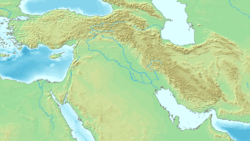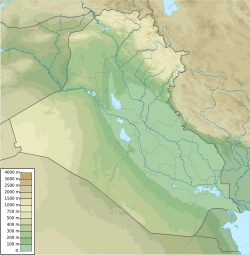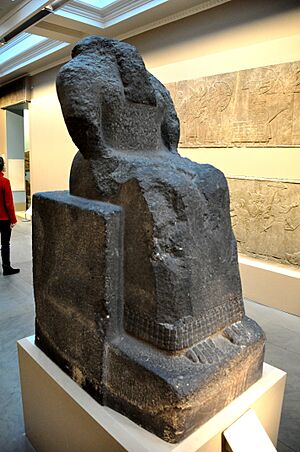Assur facts for kids
|
Aššur
ܐܫܘܪ آشور |
|
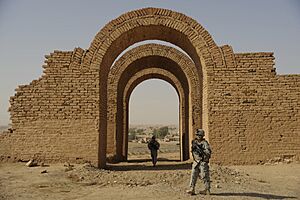
American soldiers on guard at the ruins of Ashur, 2008
|
|
| Location | Saladin Governorate, Iraq |
|---|---|
| Region | Mesopotamia |
| Coordinates | 35°27′24″N 43°15′45″E / 35.45667°N 43.26250°E |
| Type | Settlement |
| History | |
| Founded | Early Dynastic Period |
| Abandoned | 3rd century AD |
| Periods | Early Bronze Age to classical antiquity |
| Site notes | |
| Public access | Inaccessible (in a war zone) |
| Official name | Ashur (Qal'at Sherqat) |
| Type | Cultural |
| Criteria | iii, iv |
| Designated | 2003 (27th session) |
| Reference no. | 1130 |
| Region | Arab States |
| Endangered | 2003–present |
Assur (also spelled Ashur) was a very old city in Mesopotamia, which is now Iraq. It was an important capital city for the Assyrian Empire at different times. The city was located on the western bank of the Tigris River.
People lived in Assur for about 3,000 years. It started in the Early Dynastic Period and lasted until the mid-3rd century AD. The city was attacked and damaged by the Sasanian Empire around 240 AD.
Today, Assur is a World Heritage Site. This means it's a special place recognized by UNESCO for its historical importance. In 2003, it was added to a list of sites in danger. This was because a dam project threatened to flood parts of it. Later, conflicts in Iraq also put the site at risk.
Contents
Exploring Ancient Assur
Who Explored Assur?
Archaeologists started exploring Assur in 1898. These were German archaeologists. Digging began in 1900 by Friedrich Delitzsch. Later, a team led by Robert Koldewey and Walter Andrae continued the work from 1903 to 1913.
What Did They Find?
During these digs, over 16,000 clay tablets were found. These tablets had ancient writings called cuneiform texts. Many objects found were taken to Berlin, Germany. They are now part of the collection at the Pergamon Museum.
More recently, archaeologists have continued to work at Assur. B. Hrouda led excavations in 1990. R. Dittmann also worked there in 1988 and 1989.
The Name of Assur
The name Aššur was used for the city itself. It was also the name of the land ruled by the city. Plus, it was the name of the main god of the city, Aššur. The people who lived there were called Assyrians after this god. The entire nation of Assyria got its name from Assur.
Today, Assyrians still live in the Middle East. You can find them in countries like Iraq, Iran, Syria, and Turkey. Many also live in other parts of the world. The names Syria and Syriac Christians also come from the name Assyria.
History of Assur
Early Beginnings (Bronze Age)
Assur was built on a sandstone cliff. This cliff was on the west bank of the Tigris River. The city was about 35 km (24 mi) north of where the Tigris meets the lower Zab River.
Archaeological finds show that people lived here by the middle of the 3rd millennium BC. This was during the Sumerian period. The oldest parts of the city were found in the foundations of the Ishtar temple. They were also found at the Old Palace. Later, kings from the Akkadian Empire ruled the city. For a time, Assyrian governors ruled Assur under the Third Dynasty of Ur.
Old and Middle Assyrian Periods
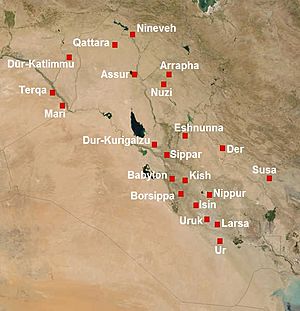
Around 2000 BC, a new dynasty started in Assur. Puzur-Ashur I founded this dynasty. His successors built temples to the gods Ashur, Adad, and Ishtar. During this time, the city built its first strong walls.
Assur became very important for trade. Merchants sent goods by caravan to Anatolia (modern-day Turkey). They traded at Assyrian colonies there, like Karum Kanesh.
A ruler named Shamshi-Adad I conquered Assur around 1813 BC. He made it his religious capital. He built a Great Royal Palace and expanded the temple of Assur. This temple included a ziggurat, which is a large stepped tower.
Later, Hammurabi, the king of Babylon, took over Assur. This happened around 1756 BC. But soon after, a native king named Adasi freed Assur from Babylonian rule.
Centuries later, King Puzur-Ashur III rebuilt the city's defenses. He also built temples to the moon god Sin and the sun god Shamash. In the late 15th century BC, the king of Mitanni conquered Assur. He took valuable items from the temple.
Ashur-uballit I overthrew the Mitanni Empire in 1365 BC. The Assyrians gained control of a large area. Over the next centuries, the old temples and palaces of Assur were restored. The city became the capital of an empire again. Kings like Tukulti-Ninurta I and Tiglath-Pileser I built new temples. The walled area of the city was about 1.2 square kilometers (0.46 sq mi).
Neo-Assyrian Empire
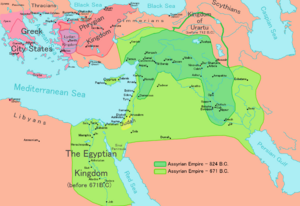
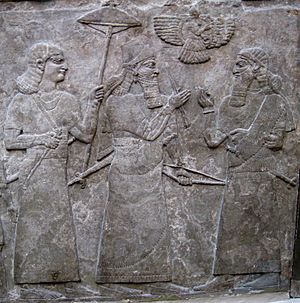
During the Neo-Assyrian Empire (912–605 BC), the kings moved their main home to other cities. Ashur-nasir-pal II moved the capital from Assur to Kalhu (Nimrud). He created amazing artworks, like huge lamassu statues. These were guardian figures with human heads, animal bodies, and wings.
Later, King Sargon II started building a new capital called Dur-Sharrukin. But he died in battle. His son, Sennacherib, chose to make Nineveh his capital instead. Assur remained the religious center of the empire. It was still seen as a holy city because of its temple to the national god Ashur.
Many kings were buried under the Old Palace in Assur. The city was largely destroyed during a major battle around 614 BC. This was when the Assyrian and Median armies fought.
Persian Rule (Achaemenid Empire)
After the Medes, the Persians took control. Assur and the region of Assyria were part of the Achaemenid Empire from 549 BC to 330 BC. Assyrians helped build palaces for the Persians. They also provided wood from Lebanon.
The city and region of Assur grew strong again. A revolt happened in 520 BC, but it failed. Assyria recovered well during this time. It became an important farming and administrative center. Assyrian soldiers were a key part of the Persian Army.
Parthian Empire
Assur became lively again during the Parthian Empire (150 BC to 270 AD). Its population grew, and it became an administrative center. New buildings were put up, including a palace. The old temple to the god Assur was rebuilt. Temples to other Assyrian gods were also restored.
Inscriptions found at Assur show that the original Assyrian culture and religion continued. These writings mention gods like Ashur, Nergal, Nanna, Ishtar, and Shamash. Some citizens had names that included the names of these gods.
The city of Assur was captured and destroyed by Ardashir I of the Sasanian Empire around 240 AD. After this, much of the city was ruined, and many people left.
Threats to Assur Today
Assur was placed on UNESCO's List of World Heritage in Danger in 2003. At that time, a large dam project threatened to flood the ancient site. The dam project was stopped after the 2003 invasion of Iraq.
In 2015, the area around Assur was taken over by the Islamic State of Iraq and the Levant (ISIL). ISIL had destroyed other ancient sites like Hatra and Nimrud. People worried that Assur would be destroyed too. Some reports said that the citadel of Assur was damaged in May 2015. However, a report from December 2016 said the damage was minor. The militants tried to destroy the city's grand entrance arches, but they were still standing.
As of February 2023, a German archaeological team has started working at Assur again. They are focusing on the "New City" area.
See also
- Ashur (god) and Ashurism
- Chronology of the ancient Near East
- Cities of the ancient Near East
- Kings of Assyria
- Short chronology timeline
- Assyrian homeland
Images for kids


